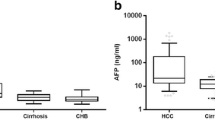Abstract
We measured des-γ-carboxyprothrombin (DCP) (prothrombin induced by vitamin K absence or antagonist-II, abbreviated as PIVKA-II) by a newly developed enzyme immunoassay using an anti-DCP monoclonal antibody in 665 human subjects, of which 112 were patients with hepatocellular carcinoma (HCC). PIVKA-II was elevated to more than 0.1 AU/ml in 54 of the 112 patients (48.2%) with HCC, while it was positive only in 7.1% of those with liver cirrhosis and 3.1% of those with chronic hepatitis. Three patients with elevated PIVKA-II greater than 0.1 AU/ml who had been diagnosed as having liver cirrhosis by ultrasonography and computed tomography at the start of this study developed a diffuse type of HCC three or six months later, which was detected by angiography. No obvious correlation was observed between plasma PIVKA-II concentration and serum α-fetoprotein (AFP) level in HCC patients. Of the 112 HCC patients, 40.2% showed an increase in AFP to above 200 ng/ml. In the remaining patients, 32.8% had a PIVKA-II concentration greater than 0.1 AU/ml. In these patients with a negative or low serum AFP concentration, PIVKA-II proved to be a valuable tumor marker for laboratory diagnosis of HCC. Among them, 59.8% tested positive for PIVKA-II and/or AFP. Thus, combination assay with PIVKA-II and AFP seems useful for increasing the accuracy of laboratory diagnosis of HCC. None of patients with a solitary tumor smaller than 2 cm had elevated PIVKA-II. In patients with larger-sized and multiple HCC, positive results of elevated PIVKA-II were more frequent than those of increased AFP. Thus, the determination of PIVKA-II may be more useful than AFP assay in patients with larger-sized and multiple tumors. The levels of plasma PIVKA-II concentration were higher in patients with larger-sized and multiple tumors than in those with smaller ones. In 20 patients, PIVKA-II decreased significantly after transcatheter arterial embolization (TAE) therapy, and in eight of these 20 patients it normalized after TAE. In conclusion, plasma PIVKA-II might be used as a valuable marker for the diagnosis and screening of HCC, especially in patients with negative or low AFP and in those with larger-sized and multiple tumors. However, its usefulness for mass screening of small HCC is limited.
Similar content being viewed by others
References
Okuda K, Liver Cancer Study Group of Japan: Primary liver cancers in Japan. Cancer 45:2663–2669, 1980
Chen DS, Sung JL: Serum α-fetoprotein in hepatocellular carcinoma. Cancer 40:779–783, 1977
Chen DS, Sung JL, Sheu JC, Lai MY, How SW, Hsu HC, Lee CS: Serum α-fetoprotein in the early stage of human hepatocellular carcinoma. Gastroenterology 86:1404–1409, 1984
Corrigan JJ: Vitamin K-dependent proteins. Adv Pediatr 28:57–70, 1981
Olson RE: The function and metabolism of vitamin K. Annu Rev Nutr 4:281–337, 1984
Liebman HA, Furie BC, Tong MJ, Blanchard RA, Lo KJ, Lee SD, Coleman MS, Furie B: Des-γ-carboxy (abnormal) prothrombin as a serum marker of primary hepatocellular carcinoma. N Engl J Med 310:1427–1431, 1984
Fujiyama S, Morishita T, Sagawa K, Sato T, Motohara K, Matsuda I: Clinical evaluation of plasma abnormal prothrombin (PIVKA-II) in patients with hepatocellular carcinoma. Hepatogastroenterology 33:201–205, 1986
Kodama T, Yokoi T, Arima K, Suga M, Imai K, Yachi A, Takahashi A, Shimamura Y: Clinical significance of abnormal prothrombin (PIVKA-II) in the plasma of patients with hepatocellular carcinoma. Tumor Res 22:63–70, 1987
Okuda H, Obata H, Nakanishi T, Furukawa R, Hashimoto E: Production of abnormal prothrombin (des-γ-carboxyprothrombin) by hepatocellular carcinoma. A clinical and experimental study. J Hepatol 4:357–363, 1987
Hattori N, Ohmizo R, Unoura M, Tanaka N, Kobayashi K, PIVKA-II Collaborative Working Group: Abnormal prothrombin measurements in hepatocellular carcinoma. J Tumor Marker Oncol 3:207–216, 1988
Fujiyama S, Morishita T, Hashiguchi O, Sato T: Plasma abnormal prothrombin (des-γ-carboxyprothrombin) as a marker of hepatocellular carcinoma. Cancer 61:1621–1628, 1988
Tanabe Y, Ohnishi K, Nomura F, Iida S: Plasma abnormal prothrombin levels in patients with small hepatocellular carcinoma. Am J Gastroenterol 83:1386–1389, 1988
Deyashiki Y, Nishioka Y, Takahashi K, Kosaka Y, Suzuki K: Evaluation of des-γ-carboxy prothrombin as a marker protein of hepatocellular carcinoma. Cancer 64:2546–2551, 1989
Tsai SL, Huang GT, Yang PM, Sheu JC, Sung JL, Chen DS: Plasma des-γ-carboxyprothrombin in the early stage of hepatocellular carcinoma. Hepatology 11:481–487, 1990
Tanikawa Y, Suzuki K, Yamazaki K: Plasma abnormal prothrombin (PIVKA-II): A new and reliable marker for the detection of hepatocellular carcinoma. J Gastroenterol Hepatol 7:1–6, 1992
Fujiyama S, Izuno K, Gohshi K, Shibata J, Sato T: Clinical usefulness of des-γ-carboxyprothrombin assay in early diagnosis of hepatocellular carcinoma. Dig Dis Sci 36:1787–1792, 1991
Soulier JP, Gozin D, Lefrere JJ: A new method to assay des-γ-carboxyprothrombin: Results obtained in 75 cases of hepatocellular carcinoma. Gastroenterology 91:1258–1262, 1986
Lawell CB: Quantitative estimation of proteins by electrophoresis in agarose gel containing antibodies. Anal Biochem 15:45–52, 1966
Shinagawa T, Ohto M, Kimura K, Tsunetomi S, Morita M, Saisho H, Tsuchiya Y: Diagnosis and clinical features of small hepatocellular carcinoma with emphasis on the utility of real-time ultrasonography: A study of 51 patients. Gastroenterology 86:495–502, 1984
Okuda K: Early recognition of hepatocellular carcinoma. Hepatology 6:729–738, 1986
Motohara K, Kuroki Y, Kan H, Endo F, Matsuda T: Detection of vitamin K deficiency by use of an enzyme-linked immunosorbent assay for circulating abnormal prothrombin. Pediatr Res 19:354–357, 1985
Ono M, Ohta H, Ohhira M, Sekiya C, Namiki M: Measurement of immunoreactive prothrombin, des-γ-carboxy prothrombin, and vitamin K in human liver tissues: Overproduction of immunoreactive prothrombin in hepatocellular carcinoma. Am J Gastroenterol 85:1149–1154, 1990
Author information
Authors and Affiliations
Rights and permissions
About this article
Cite this article
Kasahara, A., Hayashi, N., Fusamoto, H. et al. Clinical evaluation of plasma des-γ-carboxy prothrombin as a marker protein of hepatocellular carcinoma in patients with tumors of various sizes. Digest Dis Sci 38, 2170–2176 (1993). https://doi.org/10.1007/BF01299891
Received:
Revised:
Accepted:
Issue Date:
DOI: https://doi.org/10.1007/BF01299891




